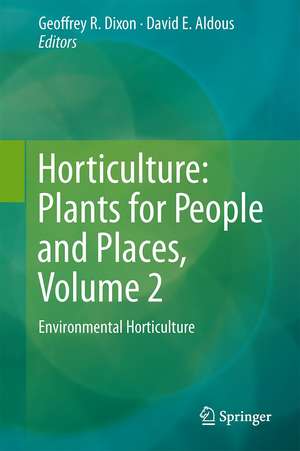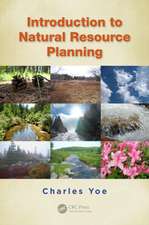Horticulture: Plants for People and Places, Volume 2: Environmental Horticulture
Editat de Geoffrey R. Dixon, David E. Aldousen Limba Engleză Hardback – iul 2014
| Toate formatele și edițiile | Preț | Express |
|---|---|---|
| Paperback (1) | 948.16 lei 6-8 săpt. | |
| SPRINGER NETHERLANDS – 27 sep 2016 | 948.16 lei 6-8 săpt. | |
| Hardback (1) | 954.14 lei 6-8 săpt. | |
| SPRINGER NETHERLANDS – iul 2014 | 954.14 lei 6-8 săpt. |
Preț: 954.14 lei
Preț vechi: 1163.58 lei
-18% Nou
Puncte Express: 1431
Preț estimativ în valută:
182.57€ • 190.62$ • 151.10£
182.57€ • 190.62$ • 151.10£
Carte tipărită la comandă
Livrare economică 05-19 aprilie
Preluare comenzi: 021 569.72.76
Specificații
ISBN-13: 9789401785808
ISBN-10: 9401785805
Pagini: 251
Ilustrații: XXI, 347 p. 65 illus., 43 illus. in color.
Dimensiuni: 155 x 235 x 22 mm
Greutate: 0.69 kg
Ediția:2014
Editura: SPRINGER NETHERLANDS
Colecția Springer
Locul publicării:Dordrecht, Netherlands
ISBN-10: 9401785805
Pagini: 251
Ilustrații: XXI, 347 p. 65 illus., 43 illus. in color.
Dimensiuni: 155 x 235 x 22 mm
Greutate: 0.69 kg
Ediția:2014
Editura: SPRINGER NETHERLANDS
Colecția Springer
Locul publicării:Dordrecht, Netherlands
Public țintă
Professional/practitionerCuprins
16. Horticulture and the Environment.- 17. Woody Ornamentals.- 18. Medicinal and Aromatic Plants – Uses and functions.- 19. Urban Greening - Macro-scale landscaping.- 20. Urban Trees.- 21. Trees in the Rural Landscape.- 22. Management of Sports Turf and Amenity Grasslands.- 23. Interior Landscapes.- 24. Biodiversity and Green Open Space.- 25. An Assessment of the Effects of Climate Change on Horticulture.- 26. Concepts and Philosophy underpinning Organic Horticulture.- Index.
Textul de pe ultima copertă
Volume two of Horticulture – Plants for People and Places provides detailed considerations of the scientific, managerial and technological concepts which underpin Environmental Horticulture. This discipline returns horticulture to its original values required for the design, husbandry and management of macro- and micro-landscapes and their constituent parts. Expert internationally acclaimed authors describe:- Horticulture and the Environment, Woody Ornamentals, Herbs and Pharmaceuticals, Urban Greening, Rural Trees, Urban Trees, Turfgrass Science, Interior and External Landscaping, Biodiversity, Climate Change and Organic Production. These subjects are united by considerations of the needs for the sustainable use of resources and careful conservation applied wherever Horticulture, natural flora and fauna, and the environment coincide. Horticulture plays a vital role in providing environmental care and supporting natural and man-made rural, urban and peri-urban landscapes. Indeed this discipline founded the basis for ecological studies, environmental science and the analysis and an increased understanding of eco-system services. This is illustrated by the current initiatives such as the development of green eco-towns and garden cities which require fundamental understandings of the controlled manipulation of plants based on the principles and practices of horticultural science for their success. Such concepts are rooted in Horticulture as illustrated by the use of plants throughout the histories of successive civilisations. These values have been vigorously applied for rejuvenating cities and communities which have been afflicted by declining economies, degraded environments, poor employment opportunities, and returning poverty. The presence of healthy plant communities provides significant economic gains in the form of environmental benefits, increased tourism, business and employment opportunities. Considerable cost-benefits are added, such as climatic amelioration, carbon sequestration, providing carbon credits and stormwater attenuation. Particular attention is given in this book to the threats posed by climate change and India is cited as a pertinent case study. Horticulture has much to offer by way of mitigation of the environmental devastation. Each of these topics is given detailed consideration by expert authors of this book.
Caracteristici
Comprehensive coverage of unique topics – no previous book has contained this amount of information covering the entire spectrum of horticulture and horticultural science from crop production through environmental contexts to social impacts and welfare benefits International authority – all the authors contributing to this trilogy are internationally acclaimed authorities each bringing vast accumulated knowledge and expertise Clear, concise and well illustrated text – each author has provided a clear, detailed but concise analysis of their field of expertise amply interpreted and illustrated for ease of reading and understanding Includes supplementary material: sn.pub/extras










